"First": whether to fly to Mars
On September 14, the series “The First” (“ The First ”) of the Hulu channel, dedicated to the first manned expedition to Mars, was released. The producer of the show was Beau Willimon, the creator of "The House of Cards", and the main role was played by Oscar-winning Sean Penn. The authors of the series already in the trailer quoted the great Karl Sagan, demonstrating the desire to present the world with a deep and philosophical picture about space exploration. And the series is really capable of making you think about the question “Why does Mars need humanity?”, Although it does this in a somewhat ambiguous way. But first things first.

The main feature of the series was his focus on astronauts family stories. There is little space in it, there is practically no Mars, but it is full of domestic problems and the psychology of relationships. So, the hero of Sean Penn, the commander of the Martian team Tom Hagerty, is torn between his professional duty and his daughter, who suffers from depression and problems with drugs. Yes, the family drama is interrupted from time to time by scenes of astronaut training sessions, searching for solutions to the engineering problems of the space mission and political intrigues around the financing of the flight to Mars (hi to the House of Cards). But nevertheless, the series first of all seeks to show how difficult it is for family members of astronauts to make their decision to leave Earth, risking never to return home. Bo Willimon spoke directly in an interviewthat did not want to immediately send their heroes to Mars, but sought to show how difficult the road to space is still on Earth.
In the "First" laid a big foundation for the future. Unlike most other films about the conquest of Mars, there is an extremely strong emphasis on realism. It is safe to say that earthlings on the Red Planet will not encounter the Martians, will not find the disputes of the next Aliens (as in the film “The Living”), will not fall into the mysterious physical anomalies (what happened in the film “Mission to Mars”), they will not chase the robot killer ("Red Planet"), do not attack the monsters from Hell ("Doom"), etc. In terms of likelihood, the First are stronger than even the Martian, which has become one of the most realistic science fiction films about Mars. After all, the film Ridley Scott for plotting the plot was necessary for a fantastic storm, which is impossible in conditions of a very thin Martian atmosphere.
However, this degree of science has its price. In order to make the series more dramatic than documentaries from National Geographic and Discovery, its authors have relied on the revelation of the characters of the characters and their personal stories. But because of the bias in the family and domestic drama, the pace of the narration becomes low by the middle of the season, the upcoming space flight turns out to be more of a reason to clarify personal relationships between the characters, and flashbacks can occupy most of the series. And at least part of the audience may seem that this is not exactly what they expected from the project. In turn, this may affect the ratings of the series and call into question its continuation in the future. It will be really sad, because the “First” has a lot of potential, which has not yet been fully revealed.
The main events of the series are shown in the early 2030s. during the preparation for the flight to Mars. The fourth industrial revolution in this world did not change the basis of human civilization. The streets of cities are not flooded with androids, flying cars do not soar in the sky, the Internet is not connected directly to the brain, and tablets have not yet been invented from old age. The Universe of the “First” is almost as far from classic cyberpunk themes as our reality. This contrasts sharply with the images of the future in the same Deus Ex: Mankind Divided and Detroit: Become Human, which takes place at about the same time.

A look at the year 2035 from 2004 (the film “I, the Robot”)
Unlike most works of the 2030s, the world of the “First” has a minimum of fantastic and just too bold assumptions in the field of technological progress. Practically all the equipment shown in the series is based on existing technologies and has all chances to appear in reality by 2032. The proximity of the reality of the series to our reality is underlined by numerous domestic scenes, style of clothing and interior design, where there is no special futurism. The “first ones” seem to be trying to show that the year 2032 is slightly more different from 2018 than the year 2018 from 2003.
Electric cars by 2030 clearly dominated by motor vehicles. That is quite possible both in the light of the current trends in the automotive industry and in the conditions of the catastrophic global warming, referred to in the series. Already today, a number of countries are planning to abandon internal combustion engines after 2025, and if climate change is gaining ever more menacing momentum, the transition to electric transport may take place much faster than the currently scheduled dates.

In addition to the electric motor, autopilot and voice-operated control took root in cars.
Television and the Internet have changed little compared with today, although the Network is not shown in particularly detail. Televisions are also popular in apartments and it seems that they are not too different from modern models.

Computer animation of the Mars mission during the broadcast of the first ever manned expedition to Mars. About 2 billion people are watching this live event.
However, big changes have come to the sphere of personal gadgets. Smartphones strongly pushed smart bracelets and ear sets, which took over most of the functions of a mobile phone. Using the bracelet, you can easily pay in the supermarket by running your hand across the packaging barcode, and the headset is worn in one ear like a hearing aid. These devices are controlled mainly by voice assistants.

Business people almost always wear such an earpiece. The
voice can also control the “smart home”, although its capabilities shown are mainly reduced to voice control of lighting in rooms and turning on the TV, as well as biometric locks in the doors. All this is already now, only in the early 2030s it became quite an ordinary element of life.
But the main household novelty became augmented reality glasses. Here, the successors of Google Glass have become ubiquitous. It’s really funny that these devices are not very diverse and it often seems that all the characters in the series have only one basic model of these points. What is strange, because with such strong demand, the market will quickly be flooded with a variety of glasses of all shapes and colors, which will become an integral feature of an individual style.
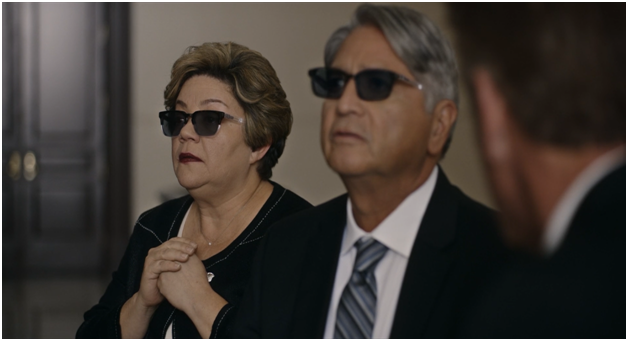
In one of the series, it is shown how a family at home in the living room watches a dance performance with the help of such glasses, fully immersed in virtual reality.
In many episodes, AR technology plays an important role and has become as integral to life as the mobile Internet in our time.

In the series, augmented reality led to the “death of a smartphone”, which some futurologists predict today. And in the scenes from the past, smartphones are repeatedly demonstrated, but by the time of the main action they almost completely disappear from sight. But how likely is such a turn in reality?
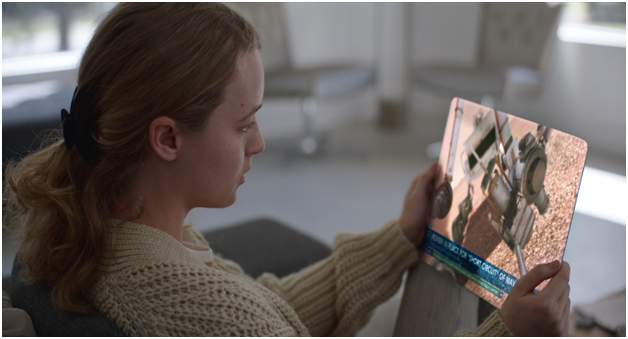
Tablets (like laptops) still remained.
Medical technologies followed the path primarily of robotization and digitalization. But with all the development of medicine, yet some diseases in the early 2030s are incurable. One of these ailments remained Alzheimer's syndrome, with which the family drama of a member of the astronaut team is associated.
Major problems remain depression and drug addiction, from which some miraculous means have not been found. And if in many films about the future they talk about various new types of drugs, then in the “First” heroin and cocaine remain the most dangerous drugs. Cannabis is also mentioned, but the truth is that its legal status in the series is not clear.

The robotic manipulator helps the doctor diagnose the auditory canal
The only truly “cyberpunk” technology of the first season was the astronauts' smart “digital twin”, which they turned on before being sent into space. There was such a curtsy for Black Mirror, however, it remains to be seen whether it will play some role for the plot in the future.

In the course of special training, the virtual clone studies the habits and character of the original, learns about his personal problems and tastes. But not everybody liked the idea of creating a digital ghost.
But the most realistic in the series shows space technology. NASA experts were involved in the creation of the show and they fully fulfilled their mission of consultants. Almost all the technologies of the Martian Odyssey shown at the moment in the series are based on real prototypes and concepts of the American Space Agency. Perhaps, if the flight to Mars will actually take place by 2032, it will be performed approximately as shown in this picture.
But before being sent into space, astronauts are forced to prepare for flights for a long time.
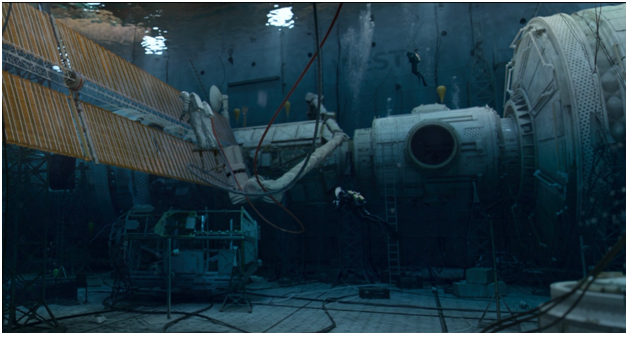
Imitation of spacewalking
The series shows classes in gyms, and training in survival in the wild, and the work of special simulators.

Preparing for the conditions of weightlessness
"First" pay a lot of attention and the problems of team building. Here are the pitfalls in the relationship between members of the future mission, and the difficulty of selecting astronauts, given that there are only five places on the interplanetary spacecraft. And only after all the difficulties of preparing for the flight, astronauts will be able to go to the launch pad.

SLS at the start
First, an astronaut team of five people is sent on the Orion spacecraft to Earth orbit using the SLS rocket.

Flight of the SLS with the Martian mission aboard.
The Orion orbit is connected to the Transit ship intended for interplanetary flight.

This ship was pre-assembled in orbit from separate units, like the Mir and ISS stations.
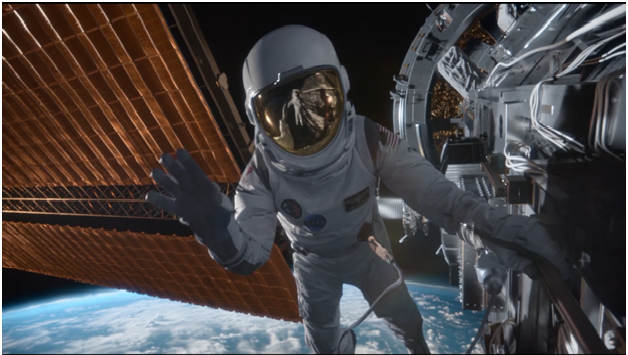
Installation work on the interplanetary ship.
After the transition to the Transit ship, astronauts must fly to Mars for 7 months. There they will spend 18 months of research, after which they will have 7 months to go home.

Testing on a simulator landing on Mars
On the Red Planet, astronauts must descend into the landing module. In the landing area, they are already awaited by a robotic mission, which generates the fuel necessary for the module to go back to the Martian orbit from the atmosphere of Mars. However, this part of the mission has already encountered a number of technical problems, and apparently in the second season it will take many more forces from the astronauts.
Both Orion and SLS are currently being actively developed by NASA, including taking into account the possibility of using these devices in a manned expedition to Mars. The first launch of the SLS rocket is scheduledfor 2020, and the first manned flight of the Orion spacecraft is planned for 2023. Although the SLS program has enough critics, there is a certain possibility that these ships will actually send people to the Red Planet in the early 2030s. And such a flight will largely have to remind what is shown in the "First."
Of course, you can not throw away a chance SpaceX ahead of everyone on the way to Mars. However, the scheme of flight to the Red Planet from the company of Ilona Mask is significantly different from NASA projects and, perhaps, the SpaceX variant will be much more difficult to implement.
The vision of the Martian mission from SpaceX
And although the Martian mission in the TV series “First” is not similar to the SpaceX plan, but Ilon Musk himself clearly became the prototype for one of the main characters in the picture. It's about Laz Ingram (played by Natasha McElhoun), the head of the private space company Vista, which is carrying out a flight to Mars. She is a tough business woman, aware that the colonization of Mars will take many human lives, but still stubbornly goes to her dream. She suffers from chronic pain, so she constantly uses analgesics, sometimes she doesn’t have relations with the press, and it is extremely necessary for her to maintain good relations with the political elite in Washington. After all, the Martian expedition is financed by the American state, and this project has enough political opponents.
On the scope of the company's activities, "Vista" says at least the construction of their own cosmodrome in the state of Louisiana, from where the astronauts will be sent to Mars. However, other projects of the company Ingram remained behind the scenes. Perhaps in the following seasons the position and prospects of private space exploration will be disclosed in more detail.
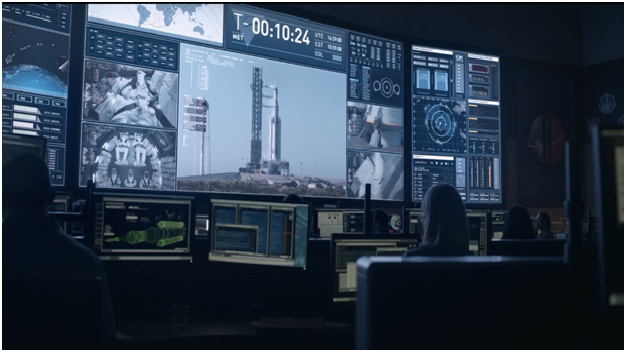
Vista Space Management Center
In general, the series impresses with its desire to show a reliable picture of space exploration. The same "Martian" in comparison with him looks like almost a fantasy movie. One has only to compare the means of flying to Mars in these sagas about astronauts of the future.

Minimalistic interplanetary station series

“Hermes” from the film “Martian” is much more expensive and complex ship, but at the same time less realistic in the early stages of the exploration of Mars. The
interior design of the interplanetary station of the series is characterized by its simplicity and functionality. It is very similar to the interior of the real ISS. Here were shown some beautiful scenes in zero gravity.

True, with all the quality of the cosmic episodes, there were very few of them, and the creators left all the most delicious things for the future.
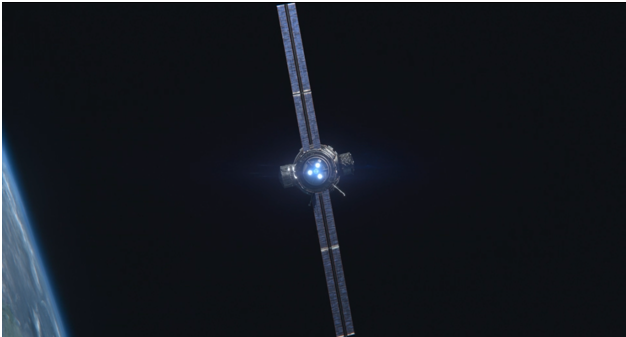
On the ionic engine to the Red Planet
Although in some places the series turned out uneven, but the story of the “First” is certainly worth attention. And this is a very beautiful picture with a budget of about $ 54.5 million.where space looks no worse than in Gravity. The series has something to forgive his sins, and he deserves to continue.

Cosmos price
The main feature of the series was his focus on astronauts family stories. There is little space in it, there is practically no Mars, but it is full of domestic problems and the psychology of relationships. So, the hero of Sean Penn, the commander of the Martian team Tom Hagerty, is torn between his professional duty and his daughter, who suffers from depression and problems with drugs. Yes, the family drama is interrupted from time to time by scenes of astronaut training sessions, searching for solutions to the engineering problems of the space mission and political intrigues around the financing of the flight to Mars (hi to the House of Cards). But nevertheless, the series first of all seeks to show how difficult it is for family members of astronauts to make their decision to leave Earth, risking never to return home. Bo Willimon spoke directly in an interviewthat did not want to immediately send their heroes to Mars, but sought to show how difficult the road to space is still on Earth.
In the "First" laid a big foundation for the future. Unlike most other films about the conquest of Mars, there is an extremely strong emphasis on realism. It is safe to say that earthlings on the Red Planet will not encounter the Martians, will not find the disputes of the next Aliens (as in the film “The Living”), will not fall into the mysterious physical anomalies (what happened in the film “Mission to Mars”), they will not chase the robot killer ("Red Planet"), do not attack the monsters from Hell ("Doom"), etc. In terms of likelihood, the First are stronger than even the Martian, which has become one of the most realistic science fiction films about Mars. After all, the film Ridley Scott for plotting the plot was necessary for a fantastic storm, which is impossible in conditions of a very thin Martian atmosphere.
However, this degree of science has its price. In order to make the series more dramatic than documentaries from National Geographic and Discovery, its authors have relied on the revelation of the characters of the characters and their personal stories. But because of the bias in the family and domestic drama, the pace of the narration becomes low by the middle of the season, the upcoming space flight turns out to be more of a reason to clarify personal relationships between the characters, and flashbacks can occupy most of the series. And at least part of the audience may seem that this is not exactly what they expected from the project. In turn, this may affect the ratings of the series and call into question its continuation in the future. It will be really sad, because the “First” has a lot of potential, which has not yet been fully revealed.
Such a close world of 2032
The main events of the series are shown in the early 2030s. during the preparation for the flight to Mars. The fourth industrial revolution in this world did not change the basis of human civilization. The streets of cities are not flooded with androids, flying cars do not soar in the sky, the Internet is not connected directly to the brain, and tablets have not yet been invented from old age. The Universe of the “First” is almost as far from classic cyberpunk themes as our reality. This contrasts sharply with the images of the future in the same Deus Ex: Mankind Divided and Detroit: Become Human, which takes place at about the same time.

A look at the year 2035 from 2004 (the film “I, the Robot”)
Unlike most works of the 2030s, the world of the “First” has a minimum of fantastic and just too bold assumptions in the field of technological progress. Practically all the equipment shown in the series is based on existing technologies and has all chances to appear in reality by 2032. The proximity of the reality of the series to our reality is underlined by numerous domestic scenes, style of clothing and interior design, where there is no special futurism. The “first ones” seem to be trying to show that the year 2032 is slightly more different from 2018 than the year 2018 from 2003.
Electric cars by 2030 clearly dominated by motor vehicles. That is quite possible both in the light of the current trends in the automotive industry and in the conditions of the catastrophic global warming, referred to in the series. Already today, a number of countries are planning to abandon internal combustion engines after 2025, and if climate change is gaining ever more menacing momentum, the transition to electric transport may take place much faster than the currently scheduled dates.

In addition to the electric motor, autopilot and voice-operated control took root in cars.
Television and the Internet have changed little compared with today, although the Network is not shown in particularly detail. Televisions are also popular in apartments and it seems that they are not too different from modern models.

Computer animation of the Mars mission during the broadcast of the first ever manned expedition to Mars. About 2 billion people are watching this live event.
However, big changes have come to the sphere of personal gadgets. Smartphones strongly pushed smart bracelets and ear sets, which took over most of the functions of a mobile phone. Using the bracelet, you can easily pay in the supermarket by running your hand across the packaging barcode, and the headset is worn in one ear like a hearing aid. These devices are controlled mainly by voice assistants.

Business people almost always wear such an earpiece. The
voice can also control the “smart home”, although its capabilities shown are mainly reduced to voice control of lighting in rooms and turning on the TV, as well as biometric locks in the doors. All this is already now, only in the early 2030s it became quite an ordinary element of life.
But the main household novelty became augmented reality glasses. Here, the successors of Google Glass have become ubiquitous. It’s really funny that these devices are not very diverse and it often seems that all the characters in the series have only one basic model of these points. What is strange, because with such strong demand, the market will quickly be flooded with a variety of glasses of all shapes and colors, which will become an integral feature of an individual style.

In one of the series, it is shown how a family at home in the living room watches a dance performance with the help of such glasses, fully immersed in virtual reality.
In many episodes, AR technology plays an important role and has become as integral to life as the mobile Internet in our time.

In the series, augmented reality led to the “death of a smartphone”, which some futurologists predict today. And in the scenes from the past, smartphones are repeatedly demonstrated, but by the time of the main action they almost completely disappear from sight. But how likely is such a turn in reality?

Tablets (like laptops) still remained.
Medical technologies followed the path primarily of robotization and digitalization. But with all the development of medicine, yet some diseases in the early 2030s are incurable. One of these ailments remained Alzheimer's syndrome, with which the family drama of a member of the astronaut team is associated.
Major problems remain depression and drug addiction, from which some miraculous means have not been found. And if in many films about the future they talk about various new types of drugs, then in the “First” heroin and cocaine remain the most dangerous drugs. Cannabis is also mentioned, but the truth is that its legal status in the series is not clear.

The robotic manipulator helps the doctor diagnose the auditory canal
The only truly “cyberpunk” technology of the first season was the astronauts' smart “digital twin”, which they turned on before being sent into space. There was such a curtsy for Black Mirror, however, it remains to be seen whether it will play some role for the plot in the future.

In the course of special training, the virtual clone studies the habits and character of the original, learns about his personal problems and tastes. But not everybody liked the idea of creating a digital ghost.
Difficult road to mars
But the most realistic in the series shows space technology. NASA experts were involved in the creation of the show and they fully fulfilled their mission of consultants. Almost all the technologies of the Martian Odyssey shown at the moment in the series are based on real prototypes and concepts of the American Space Agency. Perhaps, if the flight to Mars will actually take place by 2032, it will be performed approximately as shown in this picture.
But before being sent into space, astronauts are forced to prepare for flights for a long time.

Imitation of spacewalking
The series shows classes in gyms, and training in survival in the wild, and the work of special simulators.

Preparing for the conditions of weightlessness
"First" pay a lot of attention and the problems of team building. Here are the pitfalls in the relationship between members of the future mission, and the difficulty of selecting astronauts, given that there are only five places on the interplanetary spacecraft. And only after all the difficulties of preparing for the flight, astronauts will be able to go to the launch pad.

SLS at the start
First, an astronaut team of five people is sent on the Orion spacecraft to Earth orbit using the SLS rocket.

Flight of the SLS with the Martian mission aboard.
The Orion orbit is connected to the Transit ship intended for interplanetary flight.

This ship was pre-assembled in orbit from separate units, like the Mir and ISS stations.

Installation work on the interplanetary ship.
After the transition to the Transit ship, astronauts must fly to Mars for 7 months. There they will spend 18 months of research, after which they will have 7 months to go home.

Testing on a simulator landing on Mars
On the Red Planet, astronauts must descend into the landing module. In the landing area, they are already awaited by a robotic mission, which generates the fuel necessary for the module to go back to the Martian orbit from the atmosphere of Mars. However, this part of the mission has already encountered a number of technical problems, and apparently in the second season it will take many more forces from the astronauts.
Both Orion and SLS are currently being actively developed by NASA, including taking into account the possibility of using these devices in a manned expedition to Mars. The first launch of the SLS rocket is scheduledfor 2020, and the first manned flight of the Orion spacecraft is planned for 2023. Although the SLS program has enough critics, there is a certain possibility that these ships will actually send people to the Red Planet in the early 2030s. And such a flight will largely have to remind what is shown in the "First."
Of course, you can not throw away a chance SpaceX ahead of everyone on the way to Mars. However, the scheme of flight to the Red Planet from the company of Ilona Mask is significantly different from NASA projects and, perhaps, the SpaceX variant will be much more difficult to implement.
The vision of the Martian mission from SpaceX
And although the Martian mission in the TV series “First” is not similar to the SpaceX plan, but Ilon Musk himself clearly became the prototype for one of the main characters in the picture. It's about Laz Ingram (played by Natasha McElhoun), the head of the private space company Vista, which is carrying out a flight to Mars. She is a tough business woman, aware that the colonization of Mars will take many human lives, but still stubbornly goes to her dream. She suffers from chronic pain, so she constantly uses analgesics, sometimes she doesn’t have relations with the press, and it is extremely necessary for her to maintain good relations with the political elite in Washington. After all, the Martian expedition is financed by the American state, and this project has enough political opponents.
On the scope of the company's activities, "Vista" says at least the construction of their own cosmodrome in the state of Louisiana, from where the astronauts will be sent to Mars. However, other projects of the company Ingram remained behind the scenes. Perhaps in the following seasons the position and prospects of private space exploration will be disclosed in more detail.

Vista Space Management Center
In general, the series impresses with its desire to show a reliable picture of space exploration. The same "Martian" in comparison with him looks like almost a fantasy movie. One has only to compare the means of flying to Mars in these sagas about astronauts of the future.

Minimalistic interplanetary station series

“Hermes” from the film “Martian” is much more expensive and complex ship, but at the same time less realistic in the early stages of the exploration of Mars. The
interior design of the interplanetary station of the series is characterized by its simplicity and functionality. It is very similar to the interior of the real ISS. Here were shown some beautiful scenes in zero gravity.

True, with all the quality of the cosmic episodes, there were very few of them, and the creators left all the most delicious things for the future.

On the ionic engine to the Red Planet
Although in some places the series turned out uneven, but the story of the “First” is certainly worth attention. And this is a very beautiful picture with a budget of about $ 54.5 million.where space looks no worse than in Gravity. The series has something to forgive his sins, and he deserves to continue.
